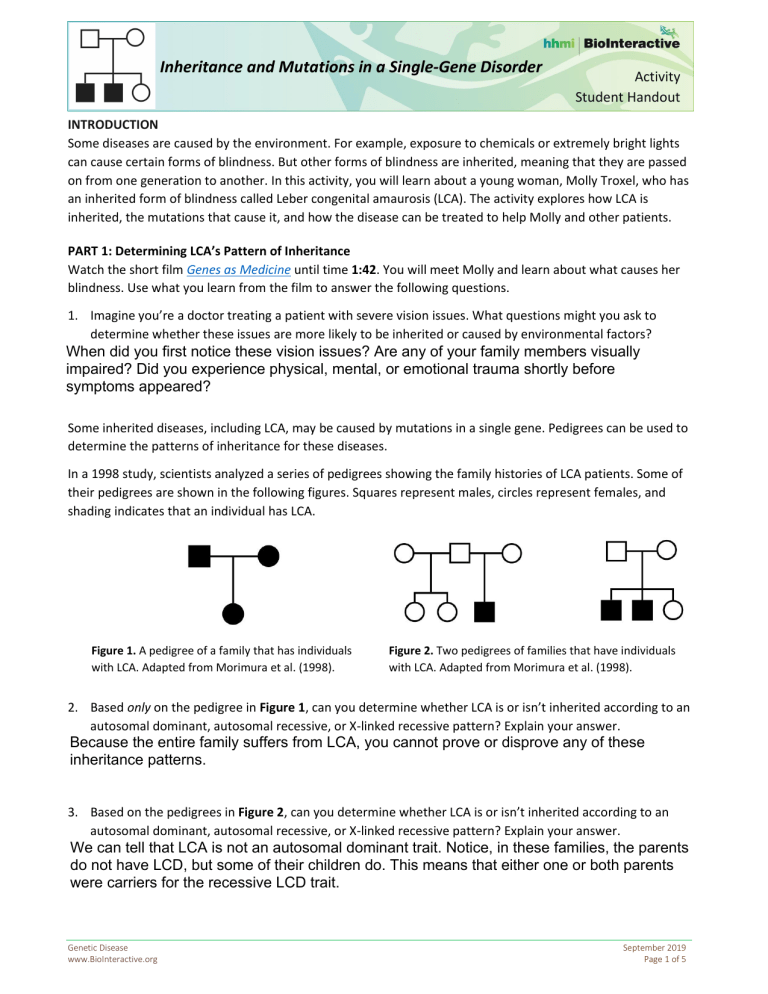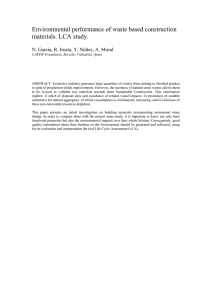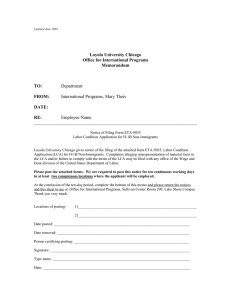
Inheritance and Mutations in a Single-Gene Disorder Activity Student Handout INTRODUCTION Some diseases are caused by the environment. For example, exposure to chemicals or extremely bright lights can cause certain forms of blindness. But other forms of blindness are inherited, meaning that they are passed on from one generation to another. In this activity, you will learn about a young woman, Molly Troxel, who has an inherited form of blindness called Leber congenital amaurosis (LCA). The activity explores how LCA is inherited, the mutations that cause it, and how the disease can be treated to help Molly and other patients. PART 1: Determining LCA’s Pattern of Inheritance Watch the short film Genes as Medicine until time 1:42. You will meet Molly and learn about what causes her blindness. Use what you learn from the film to answer the following questions. 1. Imagine you’re a doctor treating a patient with severe vision issues. What questions might you ask to determine whether these issues are more likely to be inherited or caused by environmental factors? When did you first notice these vision issues? Are any of your family members visually impaired? Did you experience physical, mental, or emotional trauma shortly before symptoms appeared? Some inherited diseases, including LCA, may be caused by mutations in a single gene. Pedigrees can be used to determine the patterns of inheritance for these diseases. In a 1998 study, scientists analyzed a series of pedigrees showing the family histories of LCA patients. Some of their pedigrees are shown in the following figures. Squares represent males, circles represent females, and shading indicates that an individual has LCA. Figure 1. A pedigree of a family that has individuals with LCA. Adapted from Morimura et al. (1998). Figure 2. Two pedigrees of families that have individuals with LCA. Adapted from Morimura et al. (1998). 2. Based only on the pedigree in Figure 1, can you determine whether LCA is or isn’t inherited according to an autosomal dominant, autosomal recessive, or X-linked recessive pattern? Explain your answer. Because the entire family suffers from LCA, you cannot prove or disprove any of these inheritance patterns. 3. Based on the pedigrees in Figure 2, can you determine whether LCA is or isn’t inherited according to an autosomal dominant, autosomal recessive, or X-linked recessive pattern? Explain your answer. We can tell that LCA is not an autosomal dominant trait. Notice, in these families, the parents do not have LCD, but some of their children do. This means that either one or both parents were carriers for the recessive LCD trait. Genetic Disease www.BioInteractive.org September 2019 Page 1 of 5 Inheritance and Mutations in a Single-Gene Disorder Activity Student Handout Figure 3 shows the pedigrees of seven families in the 1998 study. The scientists used these pedigrees to determine the inheritance pattern for LCA. Figure 3. Seven pedigrees of families that have individuals with LCA. Adapted from Morimura et al. (1998). 4. Based on the pedigrees in Figure 3, is LCA inherited according to an autosomal dominant, autosomal recessive, or X-linked recessive pattern? Use evidence from the pedigrees to support your claim, making sure to explain the evidence that rules out the inheritance patterns you didn’t choose. We can tell that LCA is an autosomal recessive trait. Notice, in sevral families, the parents do not have LCD, but some of their children do. This means that either one or both parents were carriers for the recessive LCD trait. Some duaghters have LCA, but there fathers do not. If LCA was an X linked reccessive pattern, this would not be possible becuase males on have only one copy of the x chromosome. 5. Recall that a person typically has two copies, called alleles, of every gene. One or both of these alleles may be mutated in certain individuals. Use what you know about LCA’s inheritance pattern to write the genotypes for Family #4 in Figure 3, using L to represent an unmutated allele and l to represent a mutant, disease-causing allele for the LCA-related gene. a. What are the possible genotypes of both parents in this family? Explain your answer. CHildren with LCA must have two mutant alleles. One must be from each parent. This means each parent would have to be a carrier with the genotype . Ll b. What are the possible genotypes of the female child without LCA? Explain your answer. A child could possess one of two possible genotypes. Ll means they would be a carrier, ll means they would have the disease. 6. Although Molly has LCA, her parents do not. Draw a pedigree for Molly and her parents using the same style as in the previous pedigrees. Write the genotypes for each person using L and l as before. Genetic Disease www.BioInteractive.org September 2019 Page 2 of 5 Inheritance and Mutations in a Single-Gene Disorder Activity Student Handout PART 2: Examining Mutations That Cause LCA Many genes contain instructions for making proteins, which have important functions in the body. Mutations, changes in a gene’s DNA sequence, can affect these proteins and cause inherited diseases, such as LCA. Continue watching the Genes as Medicine film until time 2:44. Figure 4 shows two illustrations from the film. Figure 4. Illustrations comparing unmutated and mutated, disease-causing copies of a gene, and their resulting proteins. 7. Based on the film, what is the difference between the two proteins shown in Figure 4? The mutated copy of the gene can have either a different function or no function. 8. Consider what mutations Molly and her parents may have in the gene related to Molly’s LCA. Using Figure 4 as a guide, draw the gene’s two alleles and their resulting proteins for both of Molly’s parents and Molly. 9. Use the diagram you drew to explain why Molly’s parents do not have LCA, but Molly does. They are only carriers for the LCA disease. This means that they still have one correct copy of the gene. Continue watching the Genes as Medicine film to time 8:47. 10. Look at the diagram shown at time 8:26 of the film. What are the similarities and differences between this diagram and the one you drew in Question 8? Molly's parents actually have different mutation in the LCA related gene. I had hypothesised that they would have the same mutation. 11. Is Molly homozygous or heterozygous for the RPE65 gene? Are her alleles for RPE65 both dominant, both recessive, or does she have one of each? Explain your answers. Molly's is heterozygous becuase each parent had a different allele for the same gene. we know that the mutated alleles are recessive becuase neither of Molley's parents suffer from LCA. Scientists can use gene sequencing to identify mutations that cause disease. Molly’s LCA, for example, was found to be due to mutations in the gene RPE65. This gene codes for a protein, RPE65, that plays an important role in the eye. Tables 1 and 2 compare parts of the unmutated RPE65 amino acid sequence with those of two LCA patients: a 9year-old and an 11-year-old. The tables show sequences for the proteins produced by each RPE65 allele in both patients. The “…” indicate amino acids in the full protein sequences that are not included in the tables. Genetic Disease www.BioInteractive.org September 2019 Page 3 of 5 Inheritance and Mutations in a Single-Gene Disorder Activity Student Handout Table 1: Partial RPE65 protein sequence (amino acids 41–60) for the 9-year-old LCA patient. Unmutated Protein Sequence START…Ser-Leu-Leu-Arg-Cyc-Gly-Pro-Gly-Leu-Phe-Glu-Val-Gly-Ser-Glu-Pro-Phe-Tyr-His-Gly…STOP Patient’s Allele 1 Protein Sequence START…Ser-Leu-Leu-Gln-Cyc-Gly-Pro-Gly-Leu-Phe-Glu-Val-Gly-Ser-Glu-Pro-Phe-Tyr-His-Gly…STOP Patient’s Allele 2 Protein Sequence START…Ser-Leu-Leu-Gln-Cyc-Gly-Pro-Gly-Leu-Phe-Glu-Val-Gly-Ser-Glu-Pro-Phe-Tyr-His-Gly…STOP Table 2. Partial RPE65 protein sequence (amino acids 61–70 and 291–300) for the 11-year-old LCA patient. Unmutated Protein Sequence START…Phe-Asp-Gly-Gln-Ala-Leu-Leu-His-Lys-Phe…Ile-Ala-Asp-Lys-Lys-Arg-Lys-Lys-Tyr-Leu…STOP Patient’s Allele 1 Protein Sequence START…Phe-Asp-Gly-Gln-Ala-Leu-Leu-Tyr-Lys-Phe…Ile-Ala-Asp-Lys-Lys-Arg-Lys-Lys-Tyr-Leu…STOP Patient’s Allele 2 Protein Sequence START…Phe-Asp-Gly-Gln-Ala-Leu-Leu-His-Lys-Phe…Ile-Ala-Asp-Lys-STOP Source: Data from Russell et al. (2017). Use Tables 1 and 2 to answer the questions below. 12. Circle the mutations in each RPE65 allele for both patients. 13. Does each patient have the same mutation in both of their alleles? Explain your reasoning. No, the 11 year old has a different mutation in each allele, but the 9 year old has the same mutaion in each. 14. Based on your answers to Questions 11 and 13, which patient’s genotype for RPE65 is more similar to Molly’s? Explain your answer. The 11 year old has a different mutation in each allele, this is simular to Molley's genotype. 15. Assume that the parents of both patients do not have LCA. a. Based on Table 1, predict the RPE65 genotypes of the parents of the 9-year-old patient. Neither parent has LCA, but both of them have one mutant allele. Becuase the kid has homozygous mutant alleles, both of her parents have one copy of the Arg-to-Gln mutation b. Based on Table 2, predict the RPE65 genotypes of the parents of the 11-year-old patient. Neither parent has LCA, but both of them have one mutant allele. The 11 year old has heterozygous mutant alleles, so both of her parents have a different RPE65 mutant allele. One parent has the Tyr-to-His substitution, and the other is missing the end of their protein (this is called a deletion). Genetic Disease www.BioInteractive.org September 2019 Page 4 of 5 Inheritance and Mutations in a Single-Gene Disorder Activity Student Handout PART 3: Using Gene Therapy to Treat LCA Continue watching the Genes as Medicine film to the end. As shown in the film, scientists treated Molly’s blindness with gene therapy. To do this, they used a modified virus to deliver copies of the unmutated RPE65 gene into cells in Molly’s eye. 16. Like Molly, the LCA patients in Tables 1 and 2 have nonfunctioning RPE65 proteins. However, their mutations in the RPE65 gene may be different from Molly’s. If so, could the gene therapy that helped Molly work for either of these patients? Justify your answer. Yes, it does not matter how the current alleles are mutated, because gene therapy gives a patient brand new copies of a properly functioning protein. So long as a patient has at least one functioning allele, the treatment should help stop disease progression, however, it may or may not reverse damage RPE65 is not the only gene that, when mutated, can cause LCA. Mutations in other genes that code for proteins involved in vision can also cause this type of blindness. 17. Do you think that the same gene therapy that helped Molly could also help LCA patients with mutations in genes other than RPE65? Explain your reasoning. This would not work because in different genes, other proteins would determine whether or not a patient suffers from LCA. You have to insert an unmutated copy of the correct protein for that particular gene. Genetic Disease www.BioInteractive.org September 2019 Page 5 of 5




